- Scientific name: Orthilia secunda
- Species of Greatest Conservation Need (MA State Wildlife Action Plan)
Description
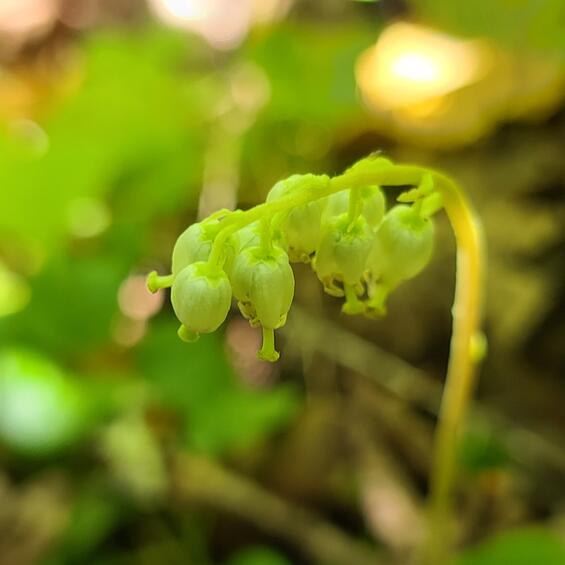
Orthilia secunda in flower
One-sided wintergreen (Orthilia secunda) is a perennial, evergreen species in the heath family (Ericaceae). It is named for the row of small flowers along one side of its bent stem. It is the only species in this genus. This wildflower has evergreen, shiny leaves in a basal whorl, sometimes smooth along their margins and sometimes with a few low teeth. It is a rhizomatous species; thus, several ramets (stems and basal whorls of leaves) can represent a single genet (genetically one individual plant, all interconnected). The ovate leaves are 1.5-4 cm (0.6-1.5 in) long. The flowering stalk is 10-20 cm (4 to 8 in) tall with crowded yellow-green flowers all on the same side (secund).
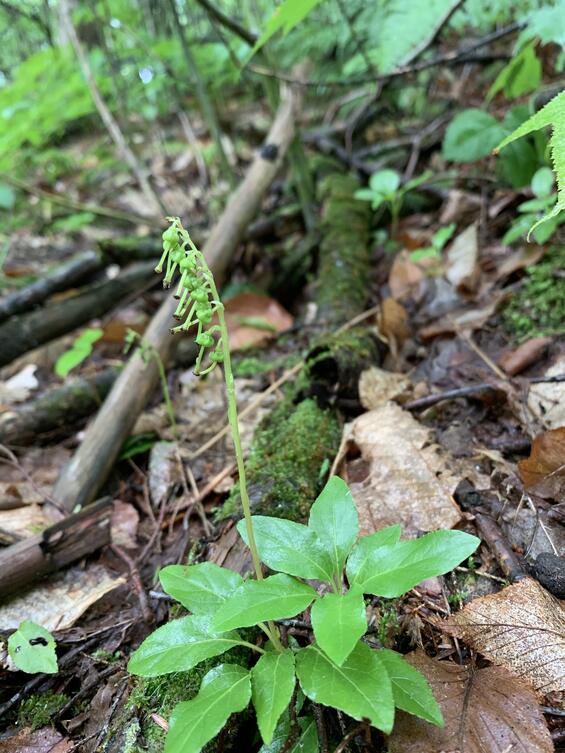
Orthilia secunda just past flowering
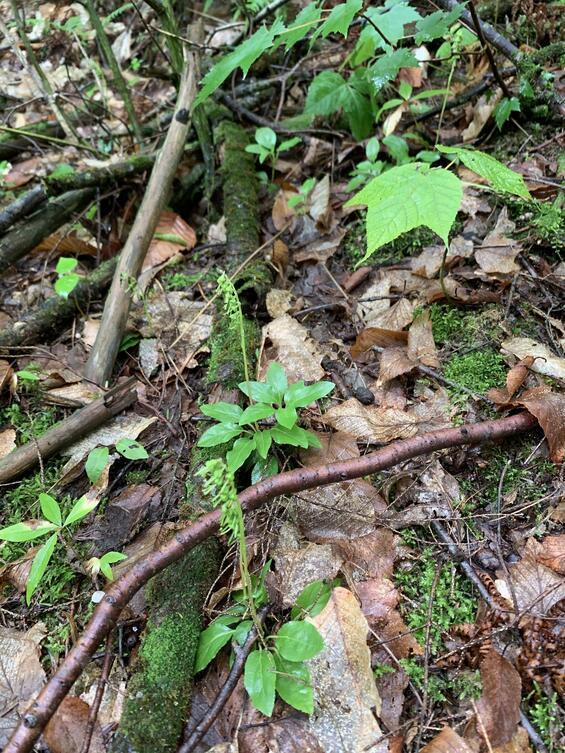
Orthilia secunda in habitat.
Life cycle and behavior
One-sided wintergreen has evergreen leaves that can be observed all year. As its habitat is often shaded by pines, one-sided wintergreen uses soil mycorrhizae to supply half its carbohydrate needs. The fungi are likely to be pulling some of the carbohydrate it feeds to one-sided wintergreen from the pine trees (Whitfield 2007). One-sided wintergreen starts to produce buds in May and flowers from June to August. Bumblebees are the primary pollinators for this species though it can self-pollinate. The dry fruiting stalk will remain until the year when the next flowers start to grow. The seed is reported to be difficult to grow. Like many orchid seeds, the extremely small seeds of one-sided wintergreen, lack sufficient nutrient reserves, and may rely on mycorrhizal fungi as they germinate and start to grow. It is thought that the seeds are dispersed by wind, and the ones closer to the parent plant are thought more likely to germinate as the fungal associate is present at the site.
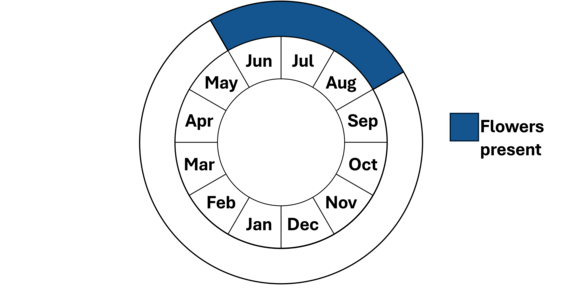
Population status
One-sided wintergreen was listed as a species of greatest conservation need in 2015 and is maintained on Massachusetts plant watch list. There are currently 7 known occurrences in the state verified since 1999 found in Berkshire and Franklin Counties. There are 116 historical herbarium records in the Consortium of Northeastern Herbaria which have not been entered in the Natural Heritage and Endangered Species Program’s database but indicate that one-sided wintergreen has occurred in the past in Berkshire, Bristol, Essex, Franklin, Hampden, Hampshire, Middlesex, Norfolk, Plymouth and Worcester Counties (CNH 2025).
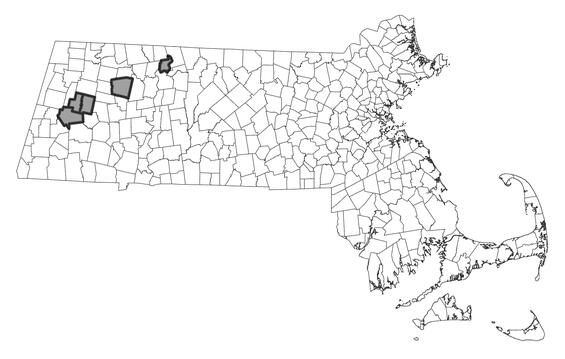
Distribution in Massachusetts. 1999-2024. Based on records in the Natural Heritage Database
Distribution and abundance
One-sided wintergreen has a circumboreal distribution, and is found throughout the northern hemisphere, from across North America, to Greenland, Europe and Asia, occurring as far south as Mexico. The species has become extirpated in several southeastern US states where it previously occurred, and its populations have decreased in other states substantially. In Massachusetts, data on its populations are just starting to be tracked by the MassWildlife’s Natural Heritage and Endangered Species Program, but recent floras indicate that it may be decreasing as it has not been relocated in historical locations (Weatherbee 1996, Bertin and Rawinski 2012). In New England, it is critically imperiled in Rhode Island, possibly extirpated in Connecticut, but secure in Vermont. It has not been given a state rank in Maine, Massachusetts or New Hampshire. In Massachusetts, there is insufficient data available to assess this species.
Habitat
One-sided wintergreen is found in moist coniferous, mixed, and deciduous forests and in mossy bogs. It can be found both within wetland areas and the adjacent uplands. It is variously described as occurring in open, rich, dry woods to deep Arborvitae swamps on mossy knolls above the water.
Healthy habitats are vital for supporting native wildlife and plants. Explore habitats and learn about conservation and restoration in Massachusetts.
Threats
The primary threats to one-sided wintergreen are not known but may include loss of habitat and climate change. As a species in the Ericaceae, it relies on a mycorrhizal association which may be disrupted by earthworms. Invasive plant species may be a threat, though it often occurs in areas with low herbaceous or shrub cover due to high shade conditions. Logging activities may destroy its habitat. Impacts to the evergreen trees from disease or changes in climate, with which one-sided wintergreen shares mycorrhizal fungi, may have severe impacts to this species.
Conservation
Survey and monitoring
In the past 10 years since this species was added as a species of greatest conservation need, the NHESP database has received only 7 records. Surveys of historical locations identified from information on herbarium sheets would be helpful to determine its status. Other de novo surveys in potential habitat would be helpful. The time to survey for this species is when it is bloom from June to August, or in the fall, when it retains its green leaves and dried stalk of seed pods.
Management
The ecological needs of one-sided wintergreen are not well known. Removal of invasive plant species may be needed, maintaining the health of the forest in which it resides is always helpful.
Research needs
As this plant is under-surveyed, more standard information is needed such as lists of associated species, comments on habitat quality and threats, and assessments of soil conditions and phenology. Research is needed to determine the mycorrhizal fungi associated with one-sided wintergreen.
References
Bertin, R.I., and T.J. Rawinski. 2012. Vascular Flora of Worcester County, Massachusetts. Special Publication of the New England Botanical Club, Cambridge, MA.
Consortium of Northeastern Herbaria (CNH). 2025. Herbarium records. https://portal.neherbaria.org/portal/collections/list.php . Accessed 4/1/2025.
Freeman, C.C. 2009. 4. Orthilia. In Flora of North America Editorial Committee, editors. Flora of North America, Volume 8, Page 388. Oxford University Press, New York, New York.
Haines, A. 2011. Flora Novae Angliae. The New England Wild Flower Society. Yale University Press, New Haven, CT.
Gleason, H.A. and A. Cronquist. 1991. Manual of Vascular Plants of Northeastern United States and Adjacent Canada, Second Edition. The New York Botanical Garden, Bronx, New York.
Minicuci, Lee. 2020. Orthilia secunda Rare Plant Profile. New Jersey Department of Environmental Protection, Division of Parks and Forestry, New Jersey Forest Service, Office of Natural Lands Management, New Jersey Natural Heritage Program, Trenton, NJ. 10 pp.
NatureServe. 2014. NatureServe Explorer: An online encyclopedia of life [web application]. Version 7.1. NatureServe, Arlington, Virginia. Available http://explorer.natureserve.org. (Accessed: January 4, 2015 ).
Weatherbee, P.B. 1996. Flora of Berkshire County, Massachusetts. The Studley Press, Inc. Dalton, Massachusetts.
Whitfield, J. Underground networking. Nature 449, 136–138 (2007). https://doi.org/10.1038/449136a
Contact
| Date published: | May 5, 2025 |
|---|